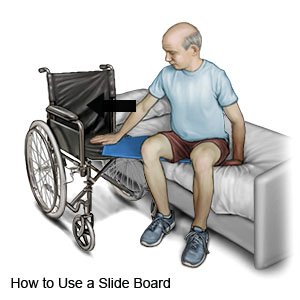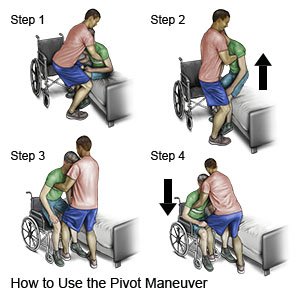Wheelchair Transfers after Spinal Cord Injury
Medically reviewed by Drugs.com. Last updated on Aug 4, 2025.
What are wheelchair transfers?
A wheelchair transfer is when you move into or out of a wheelchair. You may use a transfer or slide board to bridge the gap between your wheelchair and the bed, toilet, or bathtub. Healthcare providers may show you how to do stand-pivot-sit transfers so that a slide board is not needed.
How do I move myself into my wheelchair without help?
 |
- Position yourself at the edge of the bed or toilet in a sitting position. Keep your feet flat on the floor.
- Place your wheelchair as close to your bed or toilet as possible. Lock the wheels. Move the armrest and footrest that are closest to the bed or toilet out of the way.
- Put one edge of the slide board under your buttock and the other edge on the wheelchair seat.
- Put your hands on the bed or toilet seat, straighten your elbows, and push yourself up off the surface. Move yourself over the board in small movements until you are completely on the wheelchair. Do not drag yourself across the board. Doing this can tear or scratch your skin.
- Remove the slide board and position yourself in the middle of your wheelchair.
- Move the armrest and footrest back into place.
Related medications
How can someone help me move into my wheelchair if I need help?
- Use a slide board.
- Have another person help position you at the edge of the bed or toilet in a sitting position. Make sure your feet are flat on the floor.
- Have the person place your wheelchair as close to your bed or toilet as possible. Lock the wheels. Have the person move the armrest and footrest that are closest to the bed or toilet out of the way.
- Have the person place one edge of the slide board under your buttock. The other edge should be placed on the wheelchair seat.
- Have the person stand in front of you with his or her knees pressing against your knees to keep them stable. The person should also hold your shoulders to keep you from falling.
- Put your arms around the person's shoulders. You may also cross your arms over your chest or put your hands in your lap.
- Have the person put his or her arms around you to hold you as you lean forward.
- Have the person lift you off the bed or toilet seat and pivot toward your wheelchair. He or she may set you down on the slide board halfway through the turn if needed. He or she should not drag you across the slide board. Doing this can tear or scratch your skin.
- Have the person remove the slide board. He or she should make sure that you are positioned in the middle of the wheelchair.
- The person can then move the armrest and footrest back into place.
- Use the stand-pivot-sit method. Use this method only if the person is strong enough to help you stand and turn. This method should only be used if healthcare providers say it is okay for you to put weight on your legs. Make sure you wear non-skid shoes when you use this type of transfer.

- Have another person help you sit on the edge of your bed or toilet. Make sure your feet are flat on the floor.
- Have the person place your wheelchair as close to your bed or toilet as possible. Lock the wheels. Have the person move the armrest and footrest that are closest to the bed or toilet out of the way.
- Have the person stand in front of you with his or her knees pressing against your knees to keep them stable. The person should also hold your shoulders to keep you from falling.
- Put your arms around the person's shoulders. You may also cross your arms across your chest or put your hands in your lap.
- Have the person put his or her arms around you to hold you as you lean forward.
- Have the person lift you to a standing position. At the same time, the person presses his or her knees firmly against yours to lock your knees in the straight position.
- Have the person pivot you toward your wheelchair.
- The person should make sure that you are positioned in the middle of the wheelchair.
- Then the person can move the armrest and footrest back into place.
How do I transfer myself from my wheelchair to the toilet?
- Move the footrests out of the way and move the wheelchair close to the front of the toilet.
- Put your feet flat on the ground in front of you. Lock the wheels.
- Move to the edge of your wheelchair. Slide your pants and underwear down to your ankles. Remove the clothes from one ankle so that you can spread your legs apart.
- Put your feet flat on the floor next to the sides of the toilet. Spread your knees and ankles wider than the toilet.
- Grab the safety bars next to and behind the toilet. Facing the wall behind the toilet, lift yourself up.
- Move both hands to the bar next to the toilet. Hold the safety bar, turn your body around, and lower yourself onto the toilet.
- After you have finished and transferred yourself back to your wheelchair, move the armrest and footrest back into place.
When should I call my doctor?
- You feel you cannot make transfers by yourself and need help.
- You do not understand how to do a transfer.
- Your skin has been torn or cut during a transfer.
Care Agreement
You have the right to help plan your care. Learn about your health condition and how it may be treated. Discuss treatment options with your healthcare providers to decide what care you want to receive. You always have the right to refuse treatment. The above information is an educational aid only. It is not intended as medical advice for individual conditions or treatments. Talk to your doctor, nurse or pharmacist before following any medical regimen to see if it is safe and effective for you.© Copyright Merative 2025 Information is for End User's use only and may not be sold, redistributed or otherwise used for commercial purposes.
Further information
Always consult your healthcare provider to ensure the information displayed on this page applies to your personal circumstances.
